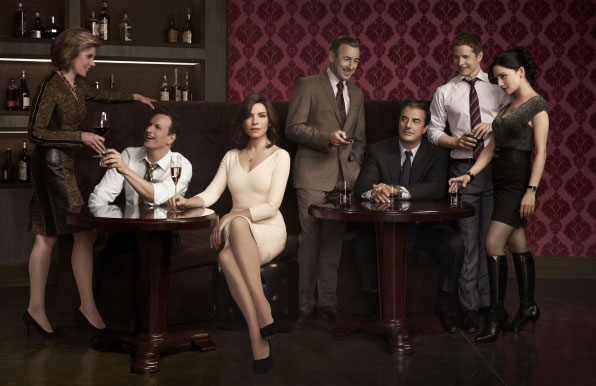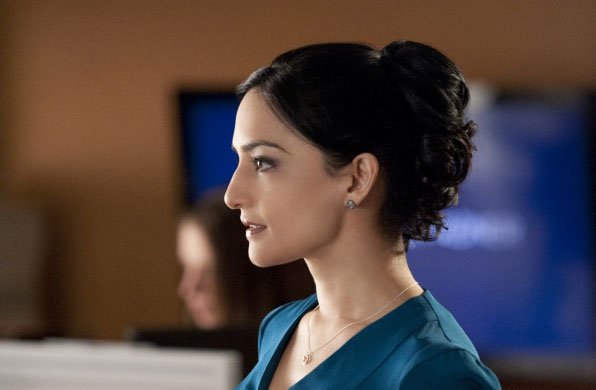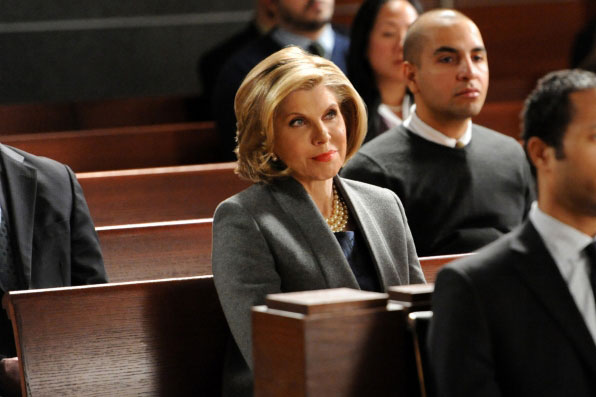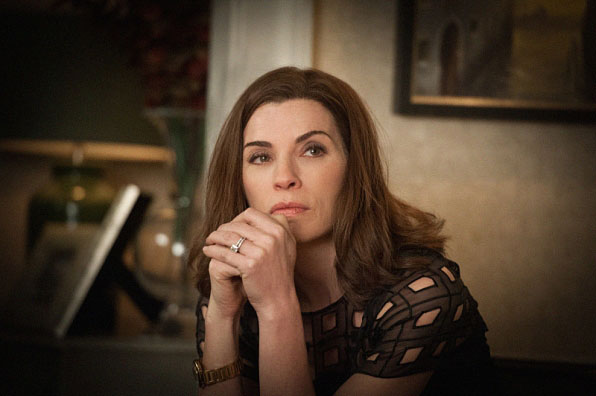It is commonly agreed that, since the debut of The Sopranos in 1999, television has gotten really good. There is now a lot of well-written, absorbing, idiosyncratic stuff to watch, and I have, helped by my insomnia, watched a lot of it.
I am a particular fan of sustained narrative series like Boardwalk Empire, Mad Men, The Wire, and House of Cards, and am looking forward to Breaking Bad and Game of Thrones. It’s nice to know that shows whose run is well underway or even long over are still available for us insomniacs on-demand or on Netflix.
But of all the long-form narrative series out there, I am most taken by the CBS series, The Good Wife (about to begin its seventh season on October 4th), though it is, by all counts, seemingly the most conventional. As a network show, it lacks the taboo-breaking characteristics of cable; if you squint, it could be a standardized legal drama. But The Good Wife is fascinating because of its female characters — not so much in their predicaments as in their appearance.
I say this knowing that female appearance has long been a problematic focus of representation. In 1971, Linda Lochlin raised the issue of woman as object rather active agent in the history of art with her essay “Why Have There Been No Great Women Artists?” In 1988, Tania Modleski extended the argument to film in The Women Who Knew Too Much, which used Alfred Hitchcock’s films to argue that women serve as “objects of the male gaze,” a positioning which makes them ideal murder victims.
The Good Wife, however, takes the sexism traditionally associated with female representation and plays around with it in interesting, third-wave feminist ways. The physical appearance of the women in this show is striking — we are meant to focus our gaze on them — but this does not support a sexist agenda.
On the contrary, their looks — or rather, how they are “made up” to look — is connected to their power and autonomy.
Before I explain further, let me sketch in the plot outline of The Good Wife for those who have been living under a rock — or who are constitutionally averse to watching network television.

The show’s premise is plucked from the news of around the time it premiered in 2009. It borrows from the case of Eliot Spitzer, forced to resign as Governor of New York after having been caught frequenting prostitutes. The famous image in media coverage was of Spitzer’s elegant, Harvard law school-educated wife standing stoically by his side as he apologized for his transgressions.
In The Good Wife, Peter Florrick (Chris Noth, retrofitting his slimy charisma as Mr. Big in Sex in the City) is an Illinois State’s Attorney, caught in a similar scandal. He goes on to spend time in prison, then rebuilds his career, eventually becoming governor of the state.
But Peter is not the focus of the show. His wife, Alicia (Julianna Margulies), is. Originally a stay-at-home mom with a legal degree, she responds to the humiliation of her husband’s wrongdoing by reassessing and taking control of her life. She gets a job with a major law firm where she prospers, then forms her own firm, then runs and briefly wins the position of State’s Attorney (another scandal interrupts that victory). As the show currently stands, she is plotting a new direction for her career.
Meanwhile, she does not divorce her husband but instead uses that relationship to her advantage as she builds successful public and exciting private lives behind the scenes. Over the course of the show’s run we have seen Alicia evolve in competence and authority, working alongside two other formidable women: a younger legal investigator, Kalinda Sharma (Archie Panjabi), and an older attorney, Diane Lockhart (Christine Baranski). The three women are not always allied, but are nonetheless positioned as a powerful triumvirate in the show.
And all three wear lots and lots of makeup.
Indeed, they wear so much that the show could be seen as a postmodern gloss on the taunt Hamlet hurls at women while holding Yorick’s skull: “let her paint an inch thick, to this favor she must come.”
Kalinda, Diane, and Alicia do paint an inch thick, but grow not more vulnerable but tougher and more competent as they do so. Their makeup signals their increasing power. It also, in some sense, gives them power.

The connection of makeup to female power is not new. It dates back to ancient Egypt and the seductive charms of Cleopatra, who managed to be both an accomplished cosmetician and a formidable foil to the Roman Empire.
If makeup conferred power in ancient times, it is not surprising that it became verboten in the Christian Middle Ages where only the male clergy were allowed to dress up. In Protestant England, the denigration of makeup on women continued both in England (e.g. Hamlet’s taunt — though, of course, Shakespeare and his troupe wore makeup to perform both male and female characters), and its offspring, Puritan America. By contrast, continental Europe grew more indulgent of makeup. Dating from the 17th-century court of Louis XIV, makeup on both men and women was an esthetic complement to intellectual salon culture.
Of course, women of all societies have used makeup under the table (or burka) all along. An ongoing question that gets raised in 19th-century novels is whether a woman “rouged.” The issue was mitigated by the late 19th-century vogue for paleness, which required another recourse – the use of arsenic, which had the advantage of doing double duty: producing a porcelain complexion and disposing of a troublesome or abusive husband.
But only with the introduction of early 20th-century entrepreneurs, many of them female immigrants from continental Europe (heirs, one might say, to the Sun King’s court of powder and patches), did lipstick, mascara, eye liner, blush, and foundation begin to gain traction in America. The linking of makeup to a vast consumer industry did a great deal to remove its stigma, though heavy makeup has, until recently, still been subject to our Puritan legacy, associated largely with street walkers and trophy wives.
The Good Wife, however, opposes that tradition. It seems to me to be the first show, set in mainstream America, to give makeup an empowering function. The women in the series wear it not so much to seduce — though they do that, too — as to make a statement about their autonomous selfhood. To successfully oppose them would require breaking through their elaborately constructed faces.
Kalinda, the young legal investigator, wears the most makeup, in keeping with her overall esthetic of tight leather skirts and spike-heeled boots. She is a praying mantis of a fashionista — as self-contained and quietly deadly as she is shiny and festooned. Though her eye makeup is the most striking element in her look, I personally am fascinated by her lips, which, in a throwback to the ’90s, involves both lip gloss and lip-liner (has anyone lined their lips since 2001?). I can’t imagine what is required to remove her makeup every night — it must take gallons of cold cream. Perhaps she doesn’t remove it and her fierceness derives from the buildup of this facial armature.

Diane, the veteran attorney, is less wildly made-up than Kalinda, but she is nonetheless slathered in layers of foundation. Where Kalinda is all about shiny, popping surfaces, Diane is about matte, making it seem as though her real face exists underground. I should add that the stylist on the show has done an inspired job with Diane’s hair: a postmodern appropriation of the 1960s “flip.” This look, once associated with bouncy beach bunnies (think Annette Funicello), has been turned into a power ’do. If Kalinda looks like a scary insect, Diane resembles a more clichéd predator — a smooth-skinned, lithely swimming shark. She could eat you for breakfast and then reapply her lipstick. The mole on her cheek, one of the few natural elements of her appearance, works well with her otherwise matte finish to both humanize and punctuate her particular variety of female power.
Finally, we have Alicia. If one has watched the show from the beginning one has seen how her makeup has grown more emphatic over time: the eyebrow pencil darker, the liner and mascara blacker, the lipstick redder, the foundation thicker. This more pronounced makeup is directly connected to her character’s development. Alicia has learned through difficult experience to use her face as a mask. Her gift for implacability — which her makeup helps to achieve — has been a key to her success.
The makeup these women wear is also related to their positioning in — and out of — time. Kalinda, the youngest of the group, exudes an aggressive, uninhibited sexuality that nonetheless seems timeworn and ageless. Diane, by all counts a “mature” woman, is so carefully airbrushed that one wouldn’t even try to postulate how old she is. Alicia’s relationship to time is the most complicated. By season six, she has a college-aged son, but she is still, as they say, “hot.” By the same token, the show is replete with close-ups that accentuate the fact that she is no longer young. For Alicia, makeup-as-mask is also makeup-as-bulwark-against-time.

One of the interesting aspects of long-playing shows is that they can relay the passage of time, both fictionally and literally. This is most obvious in Mad Men, where the ten-year period from 1960-1970 when the show is set is superimposed over the eight-year period of 2007-2015 during which it has run.
In the case of The Good Wife, we see Julianna Margulies age as Alicia Florrick does. As the character becomes a more authoritative personage, the actress’s face is painted more aggressively, both as a function of her increasing status and of the need to mask the effects of time. Still, we can see the lines around her eyes and the lipstick bleeding around her lips. The skull that Hamlet contemplated has begun to be discernible beneath the inch-thick foundation. And yet Alicia seems more attractive now than when the show began. Her makeup seems to affix more naturally to her face — which perhaps means that she has grown into her mask.
There is a paradox to these women’s appearance, of course. Their makeup which helps express their strength and individuality is, by definition, difficult and time-consuming to apply. Everyday facsimiles of Diane, Alicia, and Kalinda would have to spend hours on those little stools at the Chanel, Estee Lauder, and MAC counters, respectively, in order to achieve the looks we see on the show. Moreover, to get through the kind of days they lead — running from office to home to court to trysts with sexy colleagues — there would have to be a legion of stylists trailing in their wake, otherwise, their mascara and liner would dissolve into an inky mess, and they would look more like domestic violence victims than women warriors.
But why go there? We are in the realm of makeup as metaphor. All of these women are painted to project a mask that helps them triumph in difficult situations and which only occasionally cracks. That it does now and then is part of the point. All three women are basically good people — better than most of the men on the show. Their makeup allows them be tough and sometimes duplicitous, but it also provides us with glimpses of their vulnerability and humanity.
I hope that the show will continue for many more years, not only because I like the story lines and the characters, but because I’m curious about how the stylists will revise the female characters’ makeup. As much as I like Alicia’s look right now, at some point it is going to have to change. A woman past a certain age with very dark hair, eyebrows, and lips is going to appear clownish. There’s already a hint of Cruella de Ville about Alicia, which is fine until she starts to look full-Disney.
Perhaps in the seasons ahead, Alicia Florrick will be appointed to the Supreme Court and/or become a grandmother. These roles will require lighter hair and brows, softer eye shadow, and a more subdued lip. Of course, if Alicia goes more natural, this will involve a more complicated regimen. In the postmodern lexicon of makeup, “natural” means more makeup rather than less. •
All photos courtesy and © CBS Broadcasting Inc.




